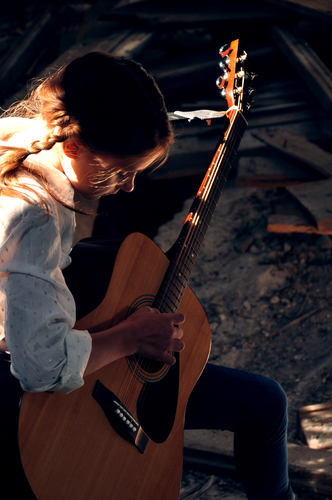
Choosing the Right Guitar for a Beginning Student

Young guitar players pick up the instrument for the first time expecting to sound like their favorite guitar heroes. Minutes into that first experience comes the stark realization that making any kind of music with this wooden contraption will take some work. Parents and guitar teachers can make this work less discouraging by helping aspiring players pick the right guitar. This isn’t just a matter of taste. Fit and quality will make a significant difference.
At the onset, most students who want to learn guitar want to play a particular kind of music. To at least some degree, this will help determine the type of first guitar for each student. Those looking to play jazz, rock, or metal will want some model of electric guitar. Those wanting to play folk or classical will want an acoustic guitar with either steel or nylon strings. Future country or blues players might benefit from starting on either an electric or acoustic. Matching the guitar with the style of music is the broadest decision in a series of decisions.
Naturally, a beginning student might want to play the exact model some guitar idol plays. You can find some top acoustic guitars under 1500 so decide on a budget and do some research. Manufacturers are aware of this, responding with signature models. Other young players might be drawn to guitars that appeal to their aesthetic sense. This is a particular trap for students looking to play rock or metal, who might long for some oddly shaped and questionably balanced instrument that could end up being a terrible fit. Parents and guitar teachers should try to quell these impulses. What a beginning player really needs is an instrument that physically fits the player’s body and is crafted well enough for the player to grow into it.
An elementary aged student really shouldn’t start on the full size guitar someone found in an attic. A young student standing around 4’ should have a ½ size guitar, regardless of whether it is an electric or acoustic. A slightly taller student standing closer to 5’ might need to start on a ¾ size guitar. Any student standing over 5’ might be able to start on a full size guitar. For comparison, a full size guitar usually has a scale length of around 25”. The scale length is the distance from the nut to the bridge. Student guitars in ½ and ¾ sizes have scale lengths around 20” or less. The actual lengths vary from model to model, so ranges are approximate. The point is a 2nd grader shouldn’t try to learn on a guitar made for an adult.
Weight and shape factor in to playability, especially for small players. Mahogany and maple woods make for heavy guitars. Woods like ash and basswood are lighter. While certain woods produce certain sounds, heavier woods could make a guitar harder to play for a developing body. Shape will be important, as guitars with deep bodies or eccentric shapes might be the ergonomic opposite of what a young player needs.
The next consideration is quality. A parent buying a guitar for a beginning player might hesitate to invest much in the instrument out of fear of the student abandoning the instrument in a matter of months. Buying a cheap guitar is a great way to ensure such a prophecy. Lesser model guitars will lack quality hardware, leading to a clumsy, difficult feel to the instrument. The responsiveness of the strings must be almost buttery. A cheap guitar with poor responsiveness will be frustrating to play. In electric guitars, cheaper models sometimes have substandard wiring. Periodically having to take a break from playing to repair the electronics will turn off a young player. Parents (and even teachers) looking to select the right guitar need not invest in a $3500 instrument, but buying anything for $100 or less could be a mistake. Expecting to spend between $200 and $300 is reasonable. The good news is most ½ and ¾ size guitars are fairly inexpensive, so that first guitar probably won’t break the bank. Eventually opting for a generic full size guitar isn’t wise, though. An instrument meant to be played for years must be built for that.
Resources abound online for how to precisely measure the right guitar for a player’s body and for selecting just the right make and model. The best advice is for the student and parent (or teacher) to visit a guitar dealer and experiment with a few guitars. All temptation to pick the coolest looking guitar should be resisted. Some instrument in that store will be the right fit. Years later when that student has built up the chops to play some pointy shred machine, he or she can wail away. Until then, the player needs to work out those chops on a good instrument that actually fits.
Written by Jeff Hartman



